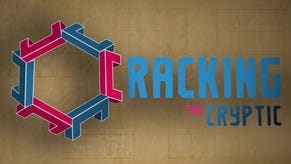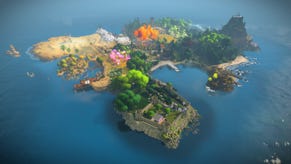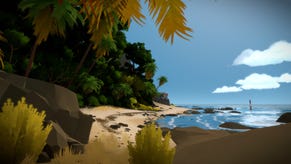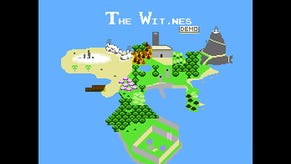The Witness: Hands On
The whole universe is in a glass of wine
In an antiquarian hotel room in London's historic Clerkenwell, Braid creator Jonathan Blow is shaking his shaven head. His laptop has decided it doesn't want to run The Witness, his new game and he's copying all the files over to his spare laptop. (If you want to know what it says about Blow that he's the sort of man who carries a spare laptop... go hire a haruspex.) The game, he tells me, has just over a year to go now, with the appearance and sound likely to change; the 300 puzzles, though, they'll stay the same. As he copies, I watch the file-names flick by: ...theater... trees... rocket launcher... caves... wait, rocket launcher? It turns out Blow was making a very different game after Braid, before the Witness and some of the files are still hanging around in The Witness.
Eventually, he finishes. We load the game, and he passes me the pad. I step out of the womb-like corridor into a clinical office, then out into the sunny yard and look down at my shadow. It is quite obviously that of a space marine. I look up, quizzical, but Blow's already leaving the room. Apparently, he doesn't want to put me off by watching.
So I start exploring. The unanimated space marine shadow is disconcerting, but like much of the game it’s place-holder. I'm using a gamepad controller because though he's brought two laptops, he's brought no mice. Outside the office is a small compound where the basic interactions of the world are explained. Several pads on posts stand near a wall, connected by a dark cable to a gate sealed by a force field. Beyond it is a bright world of sculpted landscapes, platonic objects and mini-golf buildings; it's hard to believe Blow plans to replace all this.
As I complete simple line-puzzles on the panels, connecting a starting point to an end point, the cable from each changes to white, presumably transferring power to the next. Having completed them all, the gate partially unlocks; I hunt out a button behind some bushes and a lever behind more shrubbery, and deactivate the force field completely.
From this point, this is an open world game and it's both stunning and simple to play. If you don't want to have any of the puzzles spoiled, you'd do well to stop reading. Non-spoilery material resumes after the final picture.
Still here? Don't blame me if a magical moment that would have put your future life on a blissful alternate timeline involving love, self-sufficiency and a lifetime's supply of jelly-belly has been forever lost. Blame Quinns, he's not here.

The first thing I encounter is a dictaphone on a podium. Clicking it, begins a monologue, presumably from the person who put you on the island; he talks about how warm the west of the island is, how cool and breezy the east is, and how he doesn't expect you to trust him, as he's pure “3rd act betrayal fuel” but that his “faith in you (the player) is unbreakable”. There's a plot here, but a highly abstract one, and (as we’ll show in our interview, to follow) Blow’s restless mind has lots of conceptual axes to grind.
So, I run downhill, over to another series of seven blue panels, with new white and black squares on them. I quickly get stuck; I thought I had a working theory for how the puzzles worked but it stopped when I got halfway through. I have to give up and go over to another series of three panels in front of a copse.
Each of these is structured like a branching network, stretching upward, with multiple end points at the top. I play around with the first one and find the solution by accident. I glance behind it, and see a tree silhouetted against an adobe wall. ‘He really makes beautiful trees, I'm thinking when I notice that the end point I've chosen exactly parallels an orange hanging off the tree's branches. Doing the next panel of the puzzle, I look at the tree behind that and spot another orange. I copy the pattern of its branches and the panel completes. Finally, the third tree is more gnarled and twisted over a wall; I have to clamber about to spot the orange and straighten the tree in my mind's eye to make it fit the puzzle. The cable turns white.
The white cable coming out of these three buries itself in the ground; I follow the direction it's disappeared in, as it dives in and out of the soil and brush, and get lost. The island is small, but it's complex, hilly and strangely landscaped. Blow later explains to me that he's hired architects to help him establish a pre-history for the island, re-landscape it and redesign all the buildings to reflect the multiple peoples who have lived there. It's a lot of hinterland to put into the background of a puzzle game, and is the thing that most reminds me of the obvious referent, Myst.
Over the next half hour, I wander past several other incomprehensible puzzles, escapees from Mirror's Edge: a tangle of red girders balanced along the shore like children's toys; orange geometric blocks jutting from the light blue sea; a cylindrical black monolith standing by itself in a glade; a buddha hardly noticeable in the shadow of a tree decal; a hole in a wall that forms a human face if looked at from an exact angle; an ancient oak tree covered in shoots of new life and surrounded by dead twigs. All this is place-holder?
Eventually, I head towards a nearby Tonka-toy tower which is surrounded by four mazes. The mazes exemplify both the way that Blow's puzzles progress and the way that he's actually using the complex environment which we subsconciously treat as background as elements in his puzzles. To spot the solutions, you often have to step back and force yourself to become aware of everything; it definitely makes you observe the world more keenly, but two hours of it was enough to give me a headache.
The first maze is a simple path through some fences, which you then have to draw onto a puzzle map at the end. The overgrown second maze seems to have multiple paths, but the solution is in how the grass grows, which again you have to replicate. The sandy third maze proves to be an audio puzzle, which again you have to draw on a panel at the end. The final maze is an abstraction. When you get to the panel at the end, it bears little resemblance to the open maze you just walked through; it's in those little resemblances that the solution is found though, partially a memory test, partially pure spatial reasoning. Like SpaceChem, the brainburning chase for the solution is all the fun.
Once you've completed all four, you get access to the tower itself; way at the top of it is a white button on a yellow box. Press the button and the box extends itself upwards, telescoping, before the top folds over and a pure white laser beam cuts across the sky, hitting a distant antenna atop a distant massive crag.
Chasing the laser to its target, I get distracted by other puzzles; a puzzle seemingly involving tetriminos next to another involving asterixes in a great blockhouse; an audio puzzle based around the rendering of ambient noise into puzzle panel form; a cheeky shadow puzzle; one that involves the superimposition of decal cut-outs over puzzle panels from particular perspectives; finally, what Blow later calls “a boss puzzle” that combines several of the mathematical puzzle rules, into a huge brain-teaser.

The environment is so much of the puzzles but it's also more than puzzles; an awful lot of the surroundings is just ambient. For example, well-buried in the undergrowth, are several audio buttons that reel off quotes from famous people. I stumbled across what I thought was a white concrete podium topped with small arbitrarily deposited cylindrical blocks; Blow tells me later, this is a place-holder for a picnic, complete with gingham cloth, food and a glass of wine. Hidden amidst it is a button that reels off a monologue from Feynman that begins “A poet once said 'The whole universe is in a glass of wine.' We will probably never know in what sense he meant that, for poets do not write to be understood.”
This is a game about working your mind hard, becoming aware of the world around you and coming to appreciate it how it can be integrated with puzzles about sound, shadows, texture, mathematics, location, light and memory, never knowing what’s going to be relevant to the next puzzle. Like Blow's Braid, it's also about the expression of both philosophical concepts and of intriguing, rapidly-changing mechanics, though neither of these are forced on you. They produce a coherency to the world, give a cleanness and light to The Witness that's hard to express; you'll snark me off the site for being this synaesthetic, but it feels like a mix of the contrasty cinematography of Ibsen's The Seventh Seal, the architecture of Frank Lloyd Wright and the sudden glare of fresh snow.
Blow estimates that the game is looking to come in at about ten hours long, if you can manage a puzzle every two minutes. I'd say, considering how I was mentally-blocked on about 2/3 of the puzzles, that's only a realistic number if players sleep on it; there's no way I could work through all of this in one sitting. It's also hard to believe that he considers this game still a year off, considering; but, looking at his designs for it, looking at the design portfolio he's produced, it's easy to understand that perfection is important to him. Sunday, we’ll have that angle from the man himself.








